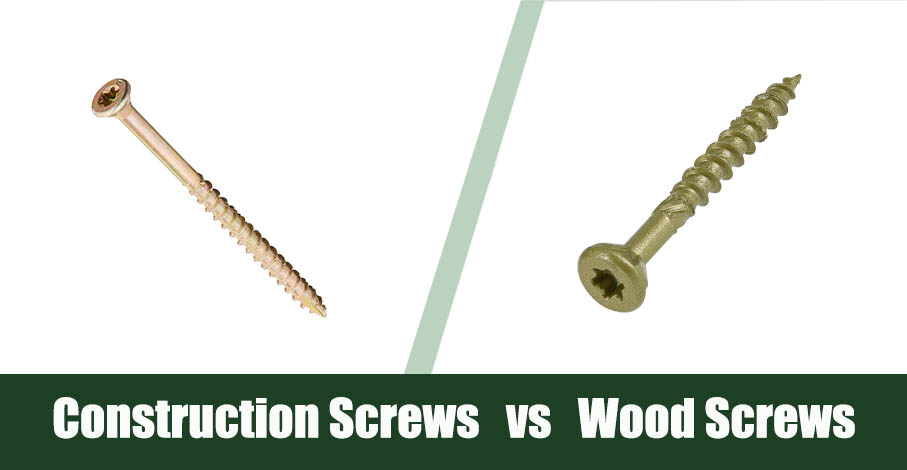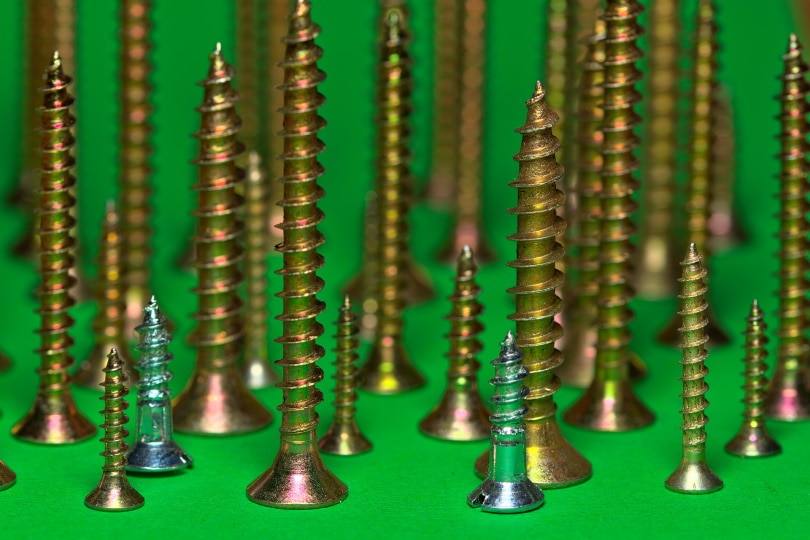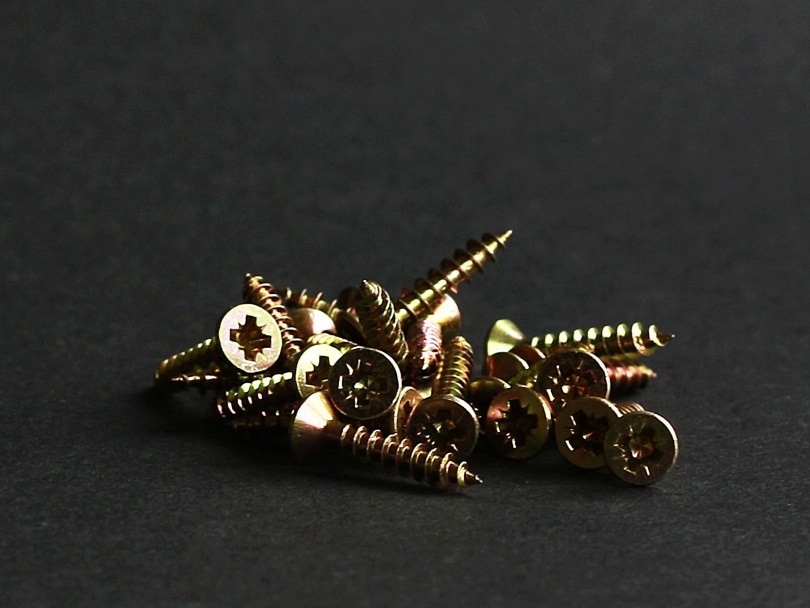Construction Screws vs Wood Screws: Pros, Cons, & Differences
-

- Last updated:

Like nails, screws are praised for their effectiveness, ease of use, and reliability. There are dozens of options available on the market, but most contractors and DIY fans prefer to use wood and construction/structural screws. They have proven to be durable and easy to find. The question is, which fasteners do you pick for your new project?
Do you use the more affordable wood screws or put your faith in the bigger and stronger construction screws? What are the pros and cons of the fasteners? How do you know which screws provide the best bang for the buck? And finally, what do the screws have in common? We have all the answers right here! Make yourself comfortable, and let’s set the record straight!

Construction Screws
Most people know what wood screws look like. The same can’t be said about construction screws, however. Also known as structural, multi-purpose, or even exterior wood screws, these fasteners are strong, durable, and praised for making long-lasting connections. So, what’s the best application(s) for such a screw? Will you need expensive tools and equipment to use it? Here’s a detailed breakdown!
Key Properties and Characteristics
Since they’re longer and larger than the average screw, construction screws are specifically designed and manufactured to handle heavy loads and high pressure. That’s precisely why structural screws are often used in construction, especially on large-scale projects. Now, to the naked eye, construction screws are almost identical to regular screws. However, if you take a closer look, you’ll see that they are slightly bigger.
More importantly, since they’re primarily used outdoors, construction screws are crafted from copper and stainless steel. Or, at the very least, they have an extra layer of coating for protection against rust/corrosion. Most manufacturers provide a 10-year guarantee against rust. As a bonus, construction screws are heat-treated. That makes them a go-to choice for humid, rainy, and dusty areas.
Are Construction Screws Easy to Use?
The fact that structural/multi-purpose screws are bigger and stronger than the average screws doesn’t mean they’re any harder to use. While it is required for some fasteners, they don’t need pre-drilled pilot holes. They go in easily, thanks to the sharp edge and the threads. However, some construction screws are not fully threaded.
Some variations have fewer threads than wood screws. Still, most construction screws have extended threads. Does that mean they take more effort to drive into a wall? If you’re using an impact driver, you won’t notice any difference. Construction screws are available with hex, spider, and Torx heads.
The Best Uses for a Construction Screw
In construction, it’s not that rare for heavy loads to damage and break regular screws. That’s why construction/structural screws were invented. Thanks to the thicker threads, they are significantly better at holding heavy boards together compared to wood screws. Plus, as mentioned, they are either crafted from resistant materials or coated to withstand the elements.
As for the biggest brands of construction screws, FastenMaster and Spax are well-known manufacturers. GRK is also quite popular, but its screws are not that easy to obtain (and they’re expensive).
- Impressive holding capacity
- Highly resistant to breakage
- Strong protection against rust
- Different heads to pick from
- Not as widely available
- A bit on the expensive side
Wood Screws
These are the most popular types of screws on the market. In fact, wood screws are more commonly used for woodworking than nails. When shopping at a hardware store, you’ll be surprised by the variety of shapes, sizes, and gauges.
However, at their core, all wood screws are the same. They are cheap, widely available, and have a decent holding strength. How efficient are they? What’s the best use for these fasteners? We’ll talk about that next!

Key Properties and Characteristics
Wood screws are usually relatively short (only 3–4-inches long) and their shafts aren’t fully threaded. When not sure what length is right for your project, pick a screw that can reach at least 2/3 of the wood board’s thickness. As for the diameter, it ranges from 1/16 inches to 5/16 inches. And what about the most common size? It’s the one with a 5/32-inch diameter (known as the #8 wood screw).
The golden standard for these screws is a tapered head, semi-threaded shaft (60–70% thread, 30–40% shank), and a pointy tip. Now, the main job of a wood screw is to join wood together. The partially threaded design makes it incredibly efficient in woodworking applications. It creates a strong bond while not causing significant damage to the wood pieces.
Are Wood Screws Easy to Use?
Wood screws are user-friendly, and as long as you have a screwdriver, drill, or driver, it shouldn’t be hard to drive them in. Wood screws aren’t only self-tapping but also self-drilling. What that means in practice is that you won’t have to make a pilot hole with a drill bit before going in with the screw. That saves a lot of time when working on big projects.
In the US, the most common wood screws come with the Phillips heads. They take little effort to drive into wood. Robertson (square) and star heads are also available but not as popular. However, regardless of the type you select, the heads won’t be easy to hide unless you paint/finish them.

The Best Uses for a Wood Screw
If you’re working on a DIY project in your garage or backyard, wood screws are ideal. As the name suggests, the screws are manufactured with wood in mind. As long as you get the right length and gauge, they do a great job of holding two regular-sized pieces of wood together. Also, make sure to get the right type of threading for the job.
Coarse threads work best on plywood and softwood, while fine threads excel at keeping hardwood together. Chairs, tables, wood fences, and cabinetry are often constructed with wood screws. However, you shouldn’t use wood screws on anything else than wood unless you don’t have another fastener handy. Most likely, you’ll end up ruining the head and damaging the metal sheet.
- Widely available, easy to work with
- Perfect for entry-level woodworking
- Great at joining low-density wood
- Keep damage to a minimum
- Hard to hide the heads
- Average holding strength
What Do Construction and Wood Screws Have in Common?
In many ways, construction screws and wood screws are quite similar. The concept is the same: we’re not dealing with bolts or nails here. Wood screws have a pointy edge, a thread, and a shank with a head at the top. This is also true for structural screws. As mentioned earlier, to a person that only uses screws occasionally they will look very much alike. Another thing that they have in common is that they’re used in woodworking.
You’ll be using the same tools for driving them in, including drills, impact drivers, and good old screwdrivers. Since there are no nuts or washers involved, it’s much easier to store wood and structural screws. Just make sure not to put them all in one box, as they’ll get mixed up. Last, but not least, while construction screws are bigger and stronger, they’re only good for wood. They can pierce through metal and concrete but won’t be able to hold anything for long.

Which Screws Cost More? How Big is the Price Difference?
Construction screws are the more expensive option. You could say that they’re the “big brother” to the cheaper, less durable wood screws. If you’re working on a heavy-load project and put safety and longevity first, structural screws are necessary. So, how much should you expect to pay for a set of these screws? It depends on the manufacturer, the diameter, length, thread count, shape of the screws, and even the area that you live in.
On average, you can get wood screws for $0.1–$0.2 each. Sometimes, they’re sold in weight (like 1–10 pounds). As for construction screws, expect the price to be 40–50% higher (or more). Yes, the price gap is quite significant, but, since a wood screw can never be as effective and reliable in heavy-duty projects as a construction screw, the somewhat steep price is more than justified. In many stores, you can buy screws in bulk to save money.
What is the Right Option for You?
It all comes down to the thickness, weight, and specifics of the wood material that you’re working with. If it’s an average DIY project (like building a raised bed, fence, or, let’s say, fixing something in the garage), wood screws will be more than enough. At the same time, when dealing with heavy hardwood that will be under pressure and high loads, we would recommend paying a bit extra for a set of structural screws.
Construction screws are more resistant to natural elements and have a higher holding strength. If that’s exactly what you’re looking for in a pack of screws, they will definitely be the right option for you. If not, wood screws will do just fine.
- Most of the work is done outdoors
- It’s a heavy-duty, heavy-load project
- Screw holding strength is a top priority
- You’re looking for quality over quantity
- No exposure to elements (indoor project)
- You’ll be working with average-sized wood
- You need handy, easy-to-use screws
- The budget for the project is limited

Conclusion
When it comes to choosing the right screws for a new project, there’s more than enough available. The tricky part is to actually find that one screw that fits your DIY beginnings best. Today, we took a look at some of the most commonly used screws: the wood and construction/structural screws.
As always, it all comes down to what you’re looking for. If it’s a cheap, easy-to-work-with fastener, go with wood screws. If you need all the holding strength and durability you can get, construction screws will do a far better job. Choose wisely, and good luck with your project!
Featured Image Credit: byrev, Pixabay
Contents

